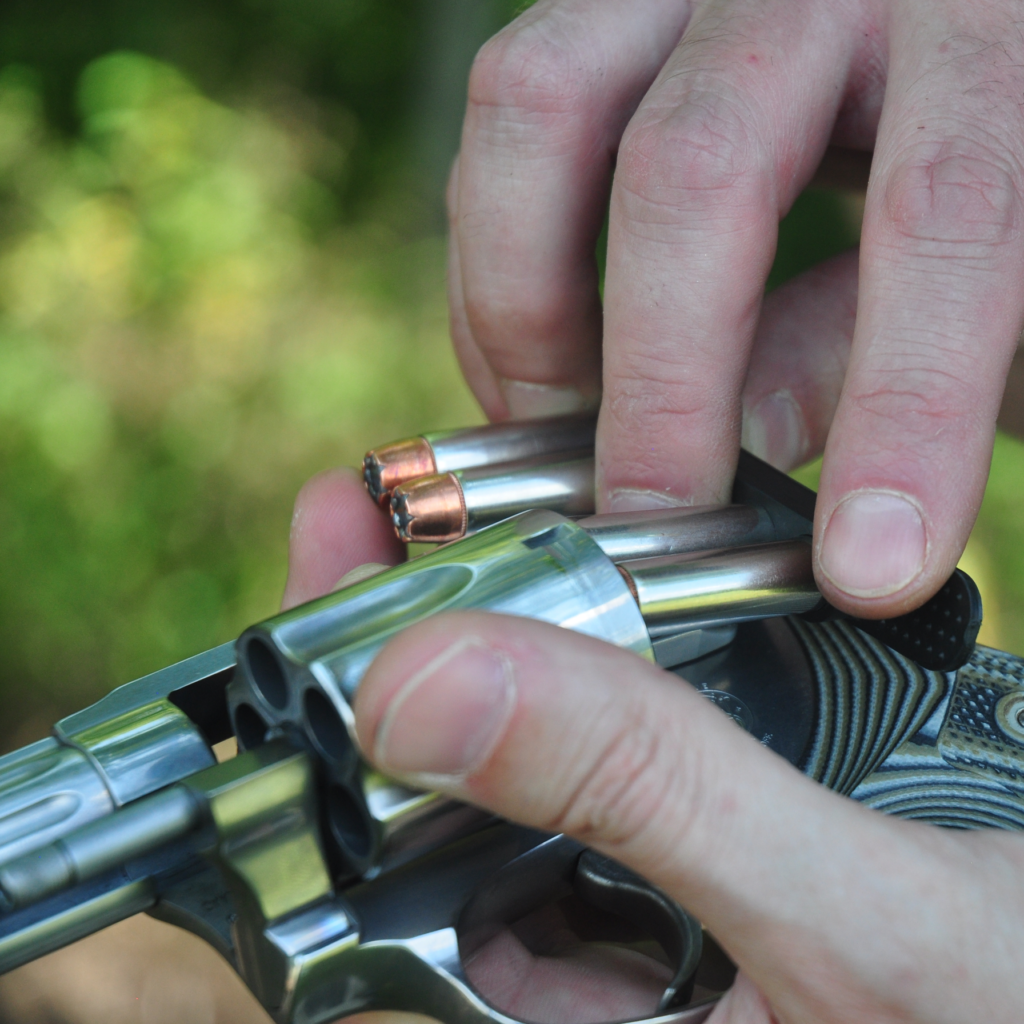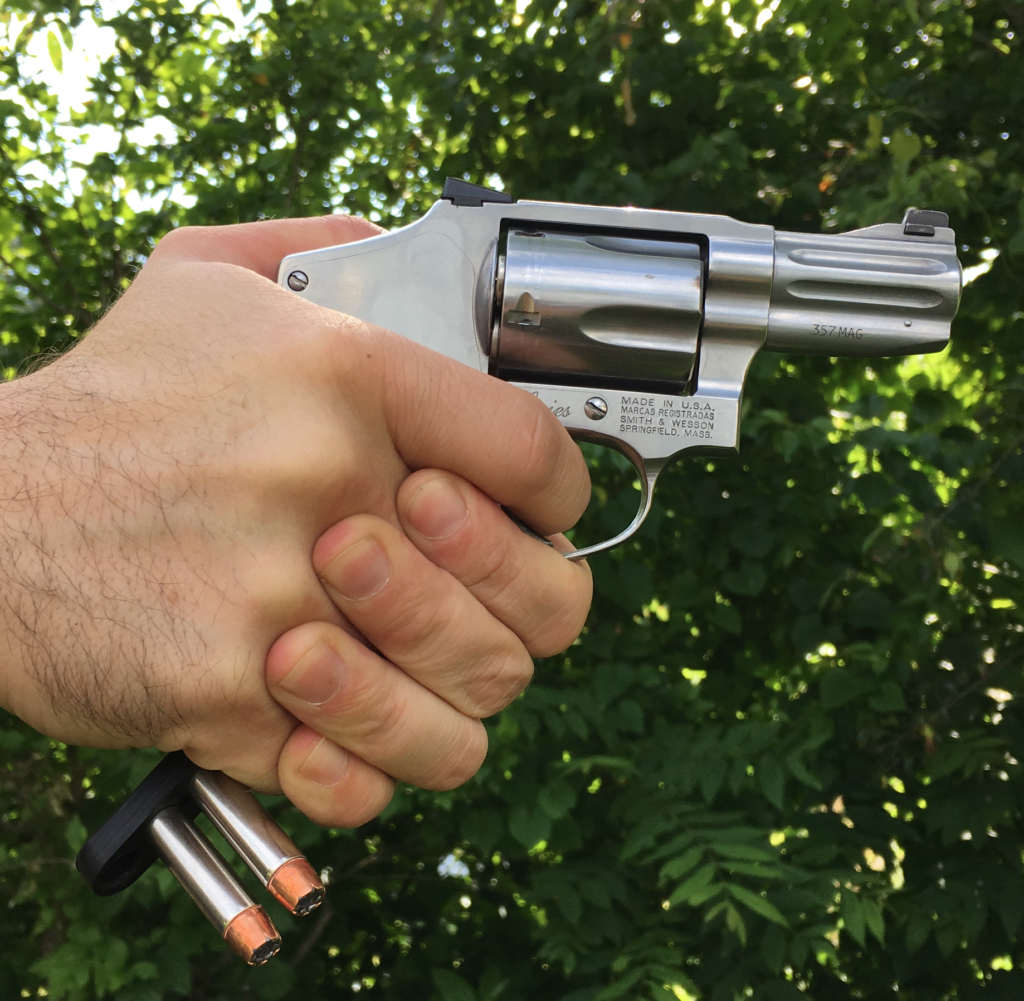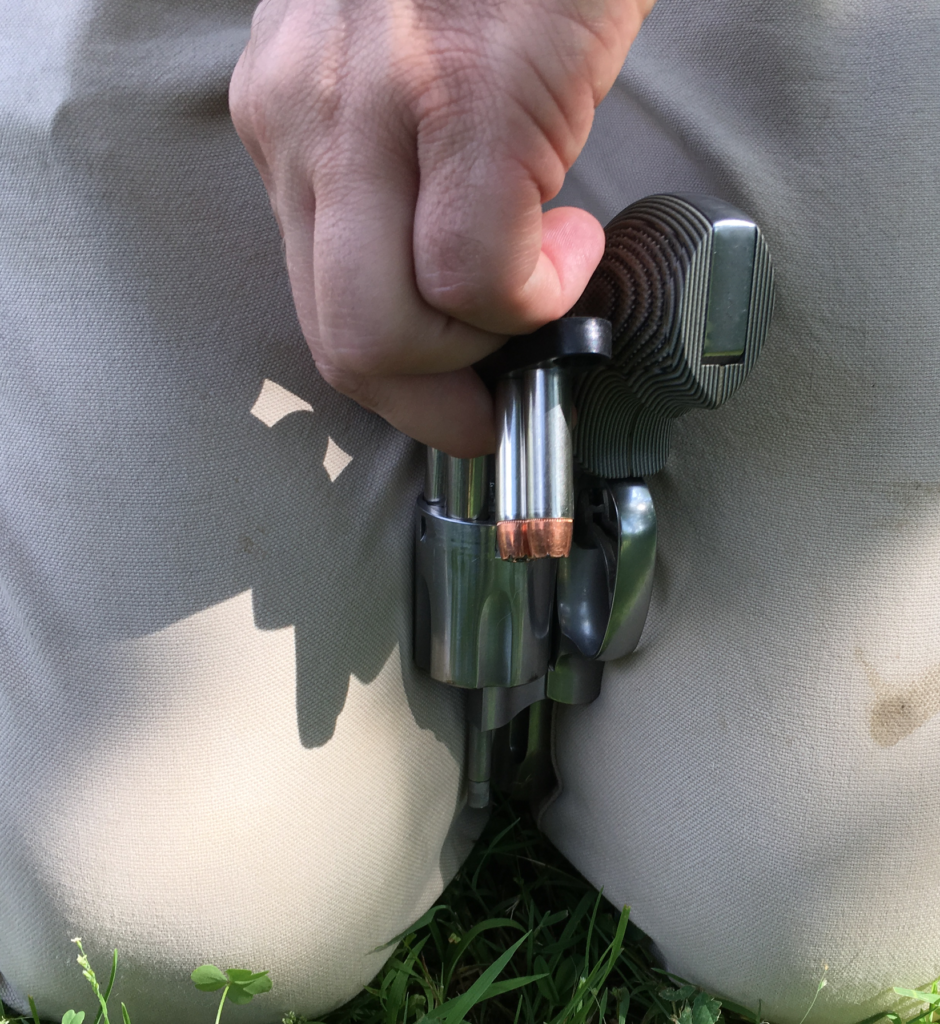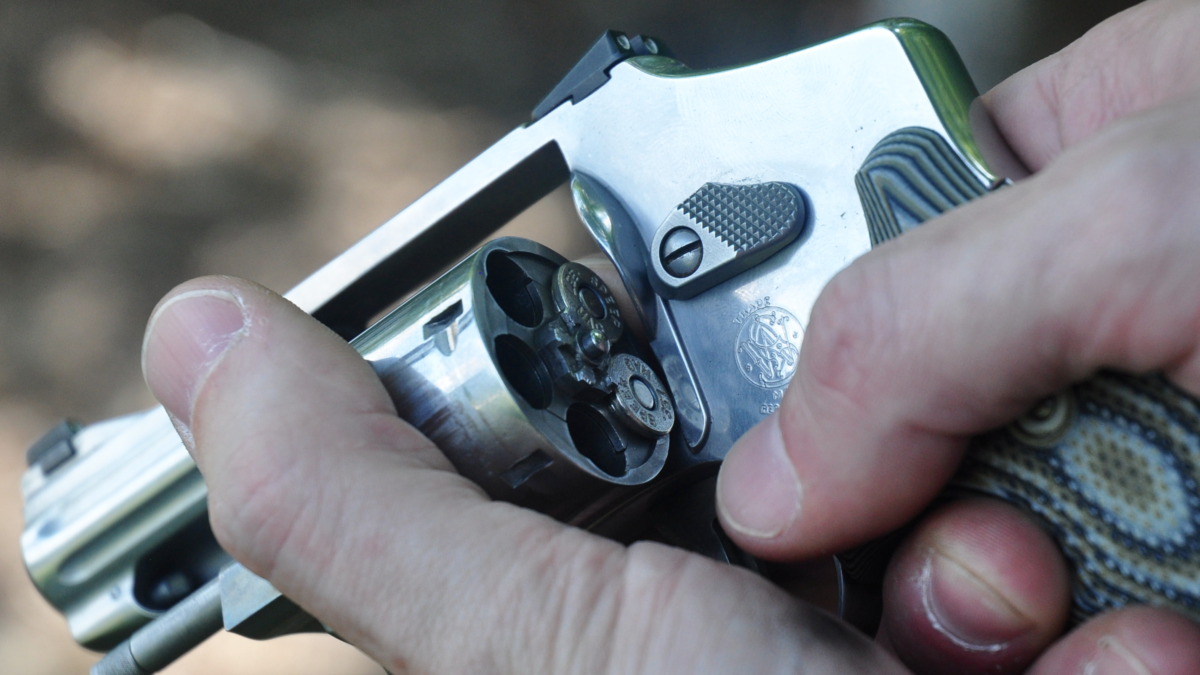In a previous post, Justin introduced the idea of the Partial Revolver Reload Drill for shooters who use the popular strip-style loaders (Speed Strip, Tuff Strip, Swift Strip, etc.), and I think it’s such a good idea that I thought I’d spend a little time discussing the concept.
Ghosts of Newhall
In his article, Justin recounted the story of Officer James E. (“Skip”) Pence, Jr., and how this valiant officer was killed while trying to reload his revolver in the infamous, 1970 gunfight in Newhall, California. Officer Pence had run his revolver dry and was struggling to complete the reload from dump pouches that were extremely difficult to use, particularly in the kneeling position he had taken behind cover. While he reloaded loose cartridges into his gun, he was shot four times with a .45 caliber pistol, sustaining wounds to both legs and his abdomen. He was able to fully load his cylinder despite these terrible injuries, but did not have time to close it before he was executed with a contact-distance shot to the back of his head.
It’s notable that Officer Pence had never been trained to do a partial load of his gun in order to get back into the fight more quickly. The stress of the gunfight, compounded by the stress of getting shot four times, kept him from coming up with this creative solution under duress, and he simply did what he had been trained to do–fully load his cylinder, before getting the gun back into action. Unfortunately, he never got that far.
Why and When?
The power of a drill like the one Justin described is that it exposes you to the idea that in some situations, it might be better to load a few rounds and close up the gun, than it would be to fully load it, first. Practicing the drill helps you to commit the option to memory, where your brain can retrieve it when the circumstances dictate, instead of using a less appropriate tactic.
What circumstance might dictate a partial load instead of a full reload? One that comes to mind is the situation that Officer Pence found himself in, with an armed opponent who is flanking your position to get a clearer shot at you, while you’re out of the fight with an empty gun. In this case, time is definitely working against you, and it’s vitally important to score a hit as soon as possible. The risk of running dry again, in short order, is outweighed by the potential reward of making a fight-stopping hit on your adversary, or maintaining a continuity of fire that interrupts his plans (i.e., forces him to return to cover and abandon the flanking attempt).
Another situation where a partial load may be advised is when you’re already injured. In this case, an already slow reload with a strip-style loader will probably take even more time. This is especially true if you’re forced to use a single hand. In this case, accepting a partial load may be necessary to prevent undue delays in returning to the fight.
Similarly, if tactical circumstances require you to abandon your position in the middle of reloading, it’s better to close up your cylinder with whatever you’ve got and get moving, than to overstay your welcome behind cover whose time limit has expired.
Know Thy Gear
One of the critical aspects of doing an efficient partial reload is knowing which way your cylinder turns. If you’re only going to load a few chambers of the cylinder, then it’s important to queue up those rounds so that they’ll be the next to fire, instead of having to work your way past several empty chambers, first. This requires you to know the direction your cylinder turns when you stroke the trigger.

On Ruger, Taurus, and almost all Smith & Wesson revolvers, the cylinder rotates counter-clockwise when the trigger is pulled. As such, it’s beneficial to stage the cylinder so that the live rounds are at the 1 O’Clock position when the cylinder is closed. For all you digital watch users and semiauto pistol fans out there, that’s where Mickey’s little hand is on the “1,” or to the right of where the hammer falls. ; ^ )
On Colt revolvers and the Smith & Wesson “M&P Bodyguard 38 Revolver” (not the classic Model 38 or 49 series “humpback” Bodyguard, but the new gun with the polymer frame and the ambidextrous cylinder release on the top of the frame), the cylinder rotates clockwise. That means that live rounds should be staged to the left of the hammer, at 11 O’Clock, to prevent unwanted clicks.
Techniques
When the cylinder is open for a reload, it’s harder to access the chambers that are closer to the frame window. Things like the grips and cylinder release tend to get in the way and rob your fingers of the clearance they need to seat cartridges with your strip loader, so most people tend to load cartridges into the outboard half of the cylinder, and rotate the cylinder as required to move the remaining empty chambers into that same position for loading.

When doing a partial load then, the chambers somewhere in the 7-to-11 O’Clock region are the ones most likely to be primed. If you’re a Colt shooter, then they’re in a good place as you swing the cylinder closed. You might hit one empty chamber before finding a live one, but you won’t have to go the long way around to find a loaded chamber. However, if you’re in the majority of revolver shooters, with a gun that rotates the cylinder counter-clockwise, those cartridges will wind up on the wrong side of the hammer if the cylinder maintains its orientation as it spins on the closing yoke or crane.
To alleviate this problem, the cylinder will need to be rolled as the yoke/crane pivots up into the locked position, to place the cartridges to the right of the hammer. Before anybody gets anxious, I’m not saying you need to send the cylinder spinning as it closes (because that can damage the bolt/cylinder stop) but I am saying that you need to roll the cylinder under positive control as you swing it into the frame, to ensure the cartridges are staged where they should be, at lockup.
Hand Jive
The question of what to do with the partially loaded strip is an important one. After doing your partial load, you essentially have three choices–drop the loader, stow it, or retain it in your hands. Each has its own advantages and disadvantages to consider.
If time is critical and you have to get back into the fight immediately, dropping the loader will allow you to do that most expeditiously. The bad thing is that you’ll probably lose access to the remaining rounds if you have to move from the position, and even if you don’t, it might take a while to recover them for another reload attempt. Still, those problems are better than trying to juggle a partially spent loader and delaying your reentry to the fight, while staring immediate doom in the face. Solve your problem, and recover the extra rounds after you’ve won your fight.
Assuming that it’s safe to spend a little extra time to retain the unloaded rounds, you can either stow them away or keep them in your hands. For the purpose of discussing these options, I’ll assume that you’ll be holding the gun in your support hand, and loading ammunition with your primary hand. Although you can load a revolver with your support hand holding the ammunition, most shooters don’t do it that way, preferring to use their more dexterous hand to load the ammo.
To stow the ammo, when the primary hand comes off the gun after stripping a few rounds into the cylinder, it moves straight to the pocket, to deposit the partially depleted loader. As the primary hand moves back to the gun, the support hand closes the cylinder and orients the gun to receive the primary hand, which can get a grip on the gun to get it back into the fight.
Because the primary hand has to make the round trip from the gun to the pocket and back to the gun, it may possibly be a little slower than keeping the loader in your hands. On the positive side, it’s the simplest and most secure way to retain the gun and extra ammo. Because the loader stays under the control of the dominant hand, and the grip on the loader doesn’t change, there’s a greatly reduced chance that it will be fumbled and dropped as it’s being stowed. The same goes for the gun, which is fully controlled by the support hand until the primary hand grip is acquired. The pocket will hold the loader securely if you have to move, and it will be easily found when it’s time to reload once more. Lastly, putting the loader in a pocket allows your hands to achieve a normal, uninterrupted grip on the revolver, which enhances control and accuracy when it’s time to shoot again.
Retaining the loader in your hands requires the shooter to shift the loader from the primary hand to the support hand after the partial load is accomplished. The loader must be transferred to the support hand because the primary hand needs an uninterrupted grip on the gun, to maximize control and accuracy.
One way to do this is to open up the last two or three fingers of the support hand after the cylinder has been closed. As the support hand continues to control the revolver between the thumb and the first one or two fingers, the loader is pinched and held between the flared fingers of the support hand. After the loader is gripped, the gun can now be passed into the primary hand, which assumes its grip and gets the gun back into play, as the support hand takes its place.

This method has the potential to be a bit faster than stowing the ammo because there is less distance for the primary hand to travel to rid itself of the loader, but it’s more complex and prone to error. There’s a significantly increased chance that either the loader or the gun will be fumbled and dropped, and the final grip on the pistol will be weakened compared to a normal hold, because the fingers that are gripping the loader won’t be in their normal position. This will lead to a decrease in control and accuracy when you pull the trigger. Additionally, when it comes time to reload again, both gun and loader will have to be shuffled once more–the gun getting swapped to the support hand, and the loader going back into the primary hand–creating another opportunity to fumble things we don’t want to drop.
Life Insurance
Practicing these techniques makes a lot of sense for those who rely on a revolver for defense. The repetitions will help to perfect your technique, but more importantly, they will help to program your mind to consider the need for a partial revolver reload in the first place.

When your mind, racing under the effects of combat stress, recognizes that the tactical circumstances may not allow you to finish a full reload with your strip loader, you’ll know what to do. Your brain will have an index card with instructions filed away that you can retrieve and execute–an advantage that Officer Pence lacked on that cold night 47 years ago, as he struggled to win his deadly fight.
God Bless, and be safe out there!
Mike


When I have practiced this, I find that the strip ends up “stuck” to my primary hand unless I make a deliberate (and exaggerated) effort to drop it. Thus I end up having to grip the revolver stocks and the strip. It isn’t the most comfortable grip, but it is doable, and I personally haven’t had it affect how the gun sits in my hand enough to create an accuracy problem.
The problem I have run into is that I mostly own Rugers, but do have a Charter Arms and an Amscor (Colt clone). Since the Armscor and Charter rotate clockwise, I have had problems with staging rounds correctly. Fortunately for me, the Amscor is a range gun that I do not carry, and the Charter is very rarely carried these days (and about half the time it’s carried, it is as a backup). Thus, I found it better for me to simply stop practicing partial reloads with my non-Ruger guns. For someone else, that solution might not be viable, and more practice is going to be necessary.
I’ve kind of found the same thing. I finally decided two things: a.) a reload with a speedloader doesn’t require a partial reload, and b.) the more time I spend practicing this, the less time I spend working on getting an accurate first shot out of the holster.
But like Mike said, if you work with speedloaders it’s not a bad idea to have this filed away in your head.
Thanks for writing in – that’s definitely valuable feedback!
Justin
When I took the Snubby course at TDI I found myself with a partially loaded speed strip in my teeth quite often. It works well.
Good idea! Thanks for writing in!
Justin
That would make the “communicate” part of “Shoot, Move, Communicate” very interesting! We’d all sound like Clint Eastwood, snarling through clenched teeth. Ha! ; ^ )
I never bothered with speed strips, because I primarily trained with and carried revolvers in my career in LE until the big semi-auto changeover. Before that we were allowed only wheelguns as off duty EDCs, and my service issued and trained us on speedloaders.
We also had old gunleather that had cartridge loops to hold the .38spl ammo floating around the armories that got issued and when it did no speedloaders were issued with those, so I as did others learned the old revolver tricks from pre-speedloader days. My favorite was the Flick and Load. I practiced firing two rounds, and behind cover while still watching the threat I trained myself to open the cylinder, half depress the extractor rod and flick the two empty casings out, then pull two fresh rounds in a single action from the loops and pop them into the empty chambers. Using this technique, instead of loading two rounds into an empty revolver and continuing with a short load, you break the action and top off the cylinder, but can close instantly if interrupted and return to action with four rounds in the weapon- Much better than being loaded with two. This can be used easily with speed strips as well, and the muscle memory you build allows this technique to work for you no matter if there are two expended rounds or if the cylinder is empty.
I still don’t own a single speed strip- I carry speedloaders, or ammo in full moon clips for my Thunder Ranch S&W Model 1950. (Full Moon Clip loading of revolvers is the very fastest reload there is BTW)
Would also work from a 2x2x2 belt pouch I imagine. I still plan on speedloaders during the fight. Partial loading only after it’s all over.
One tip I learned from and old-timer when I first bought my .357 snubbie was, to never load chambers adjacent to each other. Load one, then load one on the opposite side of the cylinder. Just like tightening lug nuts. That way if you have to snap the cylinder closed before you’re done loading, you’ll never have more than 2 empty chamber to click past to get to a live round. I don’t think I want to count on indexing the cylinder correctly and not fumbling anything under stress.
Thanks Mark. That makes sense for loading loose rounds. A speed strip might change the calculus a bit.
Solid article. Some of the concepts outlined illustrate why I have gravitated to the Zeta 6 Pak style loaders as supplemental to a speed loader, or by themselves in a minimalist approach, for my J frames. I set up their J Pak with two at one end, three at the other and one hole in the middle empty. That open space helps me get a really positive hold coming out of a pocket by hooking a finger in the gap.
I’ve also found the Zeta 6 Sym Strip to be a better solution (more robust, tabs at both ends, and better spacing between rounds) than Speed Strips or Tuff Strips, and they work in my standard (not 2x2x2) dump pouch. The rounds are spaced just a bit wider on the Sym Strip than on other brands and I find they space perfectly to a J frame cylinder. I load the Sym Strip with four and leave the fifth, center, hole empty to load effectively in pairs as well as to grip in a manner similar to what is illustrated in the article above.
Thanks Frank. Zeta6 makes some good stuff, and we’ve featured their products here numerous times (although not before this particular article was written). I found their inline strip loaders were a little long for the places I normally carry a strip, but the spacing on them is certainly a neat feature. Their Pak and Clip loaders are definitely more compact options.
All excellent information.
18 years of revolver training in the Secret Service before changing to auto loaders. Always used a speed loader, not caring for the dump pouches or loops. Consequently, partial reloads, sliding one or more live rounds out and stowing them, before discarding the empties and reloading with the speed loader was essential.
Now I’m thinking of getting a revolver that uses moon clips. Any tips on partial reloads using them?
King Davis, my good friend calls that method you described the “Reverse Tactical Reload”—dump and retain the live rounds, then punch out the empties and reload the whole cylinder at once. Kinda the opposite of traditional “tac load” methods, where you’re plucking out the empties then refilling those chambers. Honestly, I think your “reverse” method makes more sense.
Partial reloads with the clip-fed guns are problematic, for the obvious reasons. If you use half-moon clips, you could theoretically remove and replace just one of the clips as a “tac load,” but it seems like the trend has moved towards “full-moon” designs, and I’m not sure if anyone is even selling half-moons for most guns/calibers. I’ve actually only seen half-moons in their original, GI form, so unless you’re shooting a large-frame .45, you might be stuck with full-moons. With a full-moon clip, you’re basically obligated to just do a complete reload.
Thinking about those half-moons . . . if you thought you might be interested in preserving the ability to do a tac load after firing a few rounds, you’d have to pay attention to how you staged the cylinder when you shut it. You’d want to make sure that the first 3 rounds to fire would all be on the same clip, so you’d have to stage that first round in the clip at either 11:00 (Colt) or 1:00 (S&W).
My Ruger LCR will fire reliably with loose rounds inserted directly into the chambers, without using a clip, and will even allow the spent cases to fall out on 3/5 chambers just by inverting the gun. I suppose you could do a tac load in this fashion, with loose rounds, but on most guns you’d be unlikely to remove those spent cases without a tool, and I wouldn’t advise doing it, except as a very last resort.
Carrying half-moons would probably be an even bigger pain than carrying full-moons, so I’m not sure there would be much advantage. Probably best to just plan on doing a full reload with the clip guns, every time.
I appreciate Greg reviving this older post. Since it might be the first time for some of you to see it, may I also suggest you check out this other, related post from the archives? It provides a little more perspective on partial loads that you might find interesting:
https://revolverguy.com/reconsidering-revolver-tactical-reload/